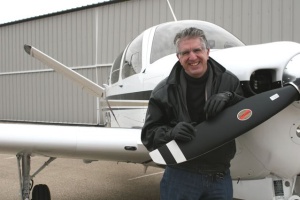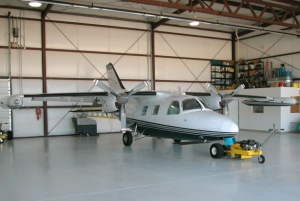Time really is on Randy Africano’s side. For the Peoria resident, Rockford—normally a two-hour-plus car ride—is only 35 minutes away, and Kankakee—also two hours by car—is a mere half-hour trip. And in less time than it takes to drive to Chicago, Africano is able to reach the southwestern prairies of Dallas. For Metamora resident Barry Logan, a hamburger from Lambert’s restaurant in Sikeston, Mo.—a five-hour car ride from Peoria—never tasted so good after just an hour of travel. “We fly into an airport and go get a hamburger instead (of driving to a local restaurant),” Logan said.
Logan and Africano’s “time machines” are being used more frequently by business travelers and customers seeking an alternative to commercial airliners. The ease of private air travel has made it so popular that the Federal Aviation Agency has projected a dramatic increase in student pilots and licensed pilots over the next decade. By 2015, the FAA forecasts a 17 percent increase in the number of flight students and a 10 percent increase in the number of licensed private pilots—up from the record lows the industry has seen in recent years. Furthermore, as the demand for corporate and ondemand flying stimulates hiring, the number of commercial pilots is also expected to increase.
Working as an aviation consultant for area emergency medical and helicopter programs, Africano turned his love of flying into his life’s work. “Flying was a passion that found its way into my business life,” he said. “It started as a passion and the ability to travel and do business with clients and expand my geographic reach…I wouldn’t have been able to do that with just an automobile.” Even with weather delays, the time savings provided by flying is significant, Africano said. For 35 years he has taken to the skies and now flies about 300 hours each year for personal and business use. On average, a pilot flying simply for recreation will log about 150 hours in a year. And time flies for the entire Africano family—his wife, Diane, and son, Nick, are both pilots, and his daughter, Haley, is currently in flight school.
Banking on the frustrations of commercial air travelers, new air taxi businesses are gearing up to take their share of the aviation market. With the recent customer service debacle of commercial airliner JetBlue—travelers spent eight hours trapped on a runwaystalled plane—the ease and convenience of private travel becomes extremely appealing. The first air taxi company, DayJet, is expected to debut in Florida next year, offering “per seat, on-demand” business jet service. Customers only pay for seats they require and don’t have to charter the entire plane for a trip.
At Executive Management Corp. in Bloomington, an executive light business jet can drop off six to eight passengers at their desired location for the per-person cost of a same-day airline booking, according to CEO Lincoln Francis. He said it’s common for customers to take off from Bloomington in the early morning hours, head to New York for business and return home that evening. There is no waiting in long lines and, because your bags travel along with you, no stressing over lost luggage. Airport horror stories become legends of the past as private travelers are able to bypass airport delays and time-consuming security procedures. In about one hour and 40 minutes, central Illinois residents can reach the nation’s capital, spend eight hours touring the city and still be home in time to watch the 10 p.m. news broadcast. “We now compete aggressively with the airline industry,” Francis said. “You’re saving a hotel room (stay) or even eliminating that cost. Aircraft charters, commonly for the extremely rich and famous, can cost around $1,000 a ticket now.”
 While Francis said commercial airlines are still necessary for most customers, competition among industry giants and discount carriers has ballooned the customer base, and more people are traveling the skies than ever before. “Most executives understand how to maximize the aircraft. They can be in two cities in one day or four cities in two days—which would normally be a five-day trip—and they’re only away for one night,” Francis said.
While Francis said commercial airlines are still necessary for most customers, competition among industry giants and discount carriers has ballooned the customer base, and more people are traveling the skies than ever before. “Most executives understand how to maximize the aircraft. They can be in two cities in one day or four cities in two days—which would normally be a five-day trip—and they’re only away for one night,” Francis said.
With 80 percent of his customers relying on him for business travel, Francis said the private aviation industry will continue to benefit from this growing market segment. Personal travelers seeking other flying options may not be trailing far behind business jetsetters. DayJet has announced plans to use the newest aircraft models to hit the runway—very light jets also known as microjets—for its air taxi service. About 2,500 Eclipse 500 microjets, each weighing less than 10,000 pounds, have already been ordered and over 250 of Cessna’s Citation Mustang very light jets are reserved for customers. Even Honda has entered the aviation market—its HA-420 very light jet is currently undergoing flight testing and is expected to debut in 2009. The six to eight passenger planes also carry a light price tag—from $1.5 million to just over $3 million—compared to heavy jets, which are at least double their cost. While there is some doubt about the overall success of very light jets, some analysts estimate that microjets used for on-demand air taxi services could take to the skies for 2,000 flight hours each year.
But even 30-year-old planes can still be used for reliable travel— provided components are regularly checked and upgraded. “You can purchase a used single-engine plane for as little as $10,000; a new plane could cost as much as $3.2 million,” Africano said. “They have to be overhauled every 2,000 hours for a single-engine plane. If you run out of (hours), you just swap engines out and you’re good to go. Paint and interior can easily be upgraded.” Logan finds that both avid travelers and pilots like to own their plane. Many join local flying clubs to have part-ownership and use of a plane, much like a condominium timeshare.
Despite a slight increase in the number of student pilot certificates— in the latter part of 2006, issuances for student pilot certificates were up 10 percent, while private issuances were down 14 percent compared to the same time in 2005, according to the Aircraft Owners and Pilots Association—the general public’s interest in aviation is not as popular as it once was. Twenty-five years ago, there were up to 800,000 general aviation pilots in the U.S.—a number which has shrunk to just under 600,000, AOPA spokesman Chris Dancy said. Headquartered in Frederick, Maryland, the AOPA is 410,000 members strong. In 1977, more than 138,000 pilot certificates were issued, but the AOPA found that only 84,866 student certificates were issued in 2006. “There’s no one reason (for less pilots),” Dancy said. “September 11th did have an effect in its aftermath, compounded by the fact that we were entering an economic downturn at the time.” People who choose to learn how to fly do so with discretionary dollars, Dancy said, therefore, a poor economy usually means less student pilots. With the economy on an upswing and business travel increasingly prevalent, the FAA forecasts a 10 percent increase in the number of licensed private pilots by 2015.
 The one-time cost of a pilot certificate can run anywhere from $5,000 to $9,000, plus 60 to 70 hours of flight time. The process can take a little less than a year or many years, depending on an individual’s schedule. But with just 14 hours of training and a little over $1,000, many people qualify to fly solo. An introductory lesson, which generally costs a nominal $50 fee, puts the flight enthusiast directly behind the controls. At Mount Hawley Airport, instructors Renae Allmond and Adama Allmond start prospective students flying on day one. “You have the controls from the start. We let you fly the plane so you get the feel of it and see if that’s what you want to do. You have to take a ride with (us) every two years to keep (your pilot’s license) up,” Renae Allmond said. “If you fly two to three times a week, you can get your license in less than six months. It’s a good investment from start to finish.”
The one-time cost of a pilot certificate can run anywhere from $5,000 to $9,000, plus 60 to 70 hours of flight time. The process can take a little less than a year or many years, depending on an individual’s schedule. But with just 14 hours of training and a little over $1,000, many people qualify to fly solo. An introductory lesson, which generally costs a nominal $50 fee, puts the flight enthusiast directly behind the controls. At Mount Hawley Airport, instructors Renae Allmond and Adama Allmond start prospective students flying on day one. “You have the controls from the start. We let you fly the plane so you get the feel of it and see if that’s what you want to do. You have to take a ride with (us) every two years to keep (your pilot’s license) up,” Renae Allmond said. “If you fly two to three times a week, you can get your license in less than six months. It’s a good investment from start to finish.”
The FAA has also done its part to make earning a pilot license easier by adding a new category, the sport pilot certificate, which requires only 20 hours of training. To bump the number of student pilots up even more, the AOPA started Project Pilot. “It’s aimed at people who are interested (in flying) but don’t know where to start,” Dancy said. “We pair up a student pilot with an experienced pilot to act as a mentor. We’ve found a student with a mentor is three times more likely to earn a pilot certificate than one who doesn’t have a mentor.”
Logan now teaches flight training at Marshall County Airport and recommends that student pilots seek out multiple instructors if necessary. “You need to find an instructor you can get along with,” Logan said. “Try out different ones and keep your interest up that way.” He said that he and his wife Karen, also a pilot, love to take their Cessna 210 for “power trips”—like lunching in Kentucky. Logan and his son Jason, who is currently a student pilot, like to take hunting trips to South Dakota; they can reach the state in three hours from central Illinois. “For me it’s the challenge of flying, you learn something every time you fly,” Logan said. “There’s always more to learn about weather, characteristics of airplanes and procedures— you never learn all there is to know.”
For more information on earning a pilot certificate and a comprehensive list of area flight schools visit www.projectpilot.org. a&s


